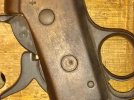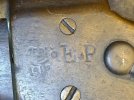I HAVE ONE!
I have no clue what I have, but this was just given to me. All I have so far are a few pics, no measurements, but the bore has some rifling and is a "forty-something." Same guy has a 7x57 he has shot and loves it.
I have a houseful of people, so won't be able to measure things or do any cleaning today, but if anyone has any idea what this might be, I'd be very appreciative of any input.
I know this isn't much to work from, but I thought maybe the markings, which are sparse, might give a general clue as to where it was intended to be sent when it was made.
I have no clue what I have, but this was just given to me. All I have so far are a few pics, no measurements, but the bore has some rifling and is a "forty-something." Same guy has a 7x57 he has shot and loves it.
I have a houseful of people, so won't be able to measure things or do any cleaning today, but if anyone has any idea what this might be, I'd be very appreciative of any input.
I know this isn't much to work from, but I thought maybe the markings, which are sparse, might give a general clue as to where it was intended to be sent when it was made.
Attachments
Last edited:


